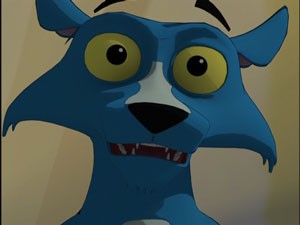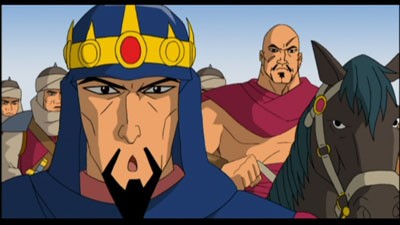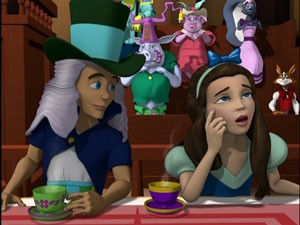| Reviews & Columns |
|
Reviews DVD TV on DVD Blu-ray 4K UHD International DVDs In Theaters Reviews by Studio Video Games Features Collector Series DVDs Easter Egg Database Interviews DVD Talk Radio Feature Articles Columns Anime Talk DVD Savant Horror DVDs The M.O.D. Squad Art House HD Talk Silent DVD
|
DVD Talk Forum |
|
|
| Resources |
|
DVD Price Search Customer Service #'s RCE Info Links |
|
Columns
|
|
|
Animated Family Adventures

Jungle Book: Rikki-Tikki-Tavi to the Rescue takes a bit of the familiar Kipling story as seen in Disney's classic, while inserting Rikki as a main "narrator" character. The story is told somewhat in flashback by Rikki, who introduces himself as a snake-mangling mongoose. The story begins with Mowgli, as a baby, deserted in the jungle. However, the danger of the fierce tiger Shere Khan has a hankering for a man-cub luncheon. Thanks to the apes and Bagheera the Panther, Khan is pushed into the mud to allow Mowgli's escape. He and Baloo the Bear now must figure out what to do with this baby in a basket. After years of being raised by the wolves, the pack decides it's time for him to leave when the threat of Shere Khan becomes too much. After yet another narrow escape from Khan, Mowgli finds himself amidst human natives who ironically look at him as a savage. A young girl of the tribe befriends Mowgli and he soon learns how to live with people. Khan returns yet again as a threat to both the animals and humans. Both sides must work together to get rid of the tiger for good.
Animation on Jungle Book is actually quite good, even if not "great" by Pixar/DreamWorks standards. Every scene is full of vivid colors and swift "camera" movement. Character designs are pleasant, except for Mowgli. Compared to the more stylized animals, his face simply takes on a wax figure look akin to characters in The Polar Express except with more primitive graphics. One problem with the narrative, though, is the constant interruption of the story by asides by Rikki-Tikki-Tavi. It's either him making karate moves in the air, pointing out an absurdly obvious Star Trek reference, or pointing out how important he is to the story. The voices are surprisingly appropriate, even if it's not Phil Harris and George Sanders in the cast. Had this not the distractions and better animation on Mowgli, this would be the best of BKN's efforts so far.

Ali Baba and the Forty Thieves: The Lost Scimitar of Arabia follows Prince Ali's quest to find the Sultan - his father. After horseback riding in England with his beloved Morgana, an attempt is made on his life, after a cascade of rocks fall from a tower. Meanwhile, the Sultan becomes aware of his brother Kasheem's plans to usurp his kingdom. General Jamal leads these ruffians in devotion to him. Back in England, Ali retells the story of his father. During a horrible draught, a mysterious old man, Sage Feisal, hands him a magical staff to lead his people by. His brother soon becomes jealous of the powers of oasis-creation amidst the arid desert. This explains the bitter rivalry. Kasheem goes on to invade the Sultan's palace to steal the object of magic, effective becoming the Sultan himself. Ali, haunted by dreams of the horrors across the globe, must travel back to his kingdom to find his father. He sets sail for Arabia, only for his stable boy to stow away in a lifeboat. Kasheem, alerted of his voyage, becomes enraged and calls for Ali's blood. An assassin makes an attempt on Ali's life while on the ship, only to be tossed into the water seemingly to drawn. This leads to a charming musical segway with the shipmates. Back in Arabia, Kasheem is horrified to find that the royal treasure has been completely depleted due to the Sutan's generosity to the poor. He proceeds to raise taxes three-fold - and dissenters are to be executed on-sight. Ali finds that he is the only one who can save the kingdom - with the aid of the fabled Lost Scimitar of Arabia. Facing battle with the dreaded Kasheem and his cohorts, the odds stack up. Will Prince Ali be able to save his father and his kingdom, as well as get rid of the evil Kasheem?
After getting used to the CGI style from BKN, this traditionally animated effort may not be the most exciting, but it works as a low-key adventure. The animation takes on a comic book look, much like the 1990s Marvel television shows. Backgrounds appear to be lush watercolors with muted details. There are some good effects here and there, such as using rack focus (different planes of focus in a shot) and good use of widescreen framing. The low budget animation only occasional shows, with background crowds seemingly made up of only 5-6 frames held on a loop. Prince Ali could probably been a bit better designed, considering he's drawn a bit too effeminate. The voice actors are generally good, even if a few characters sound silly such as the magic old man in the flashback. While nearly all characters have appropriate accents, the occasional comic relief character pops in with an exaggerated Brooklyn accent.

Alice in Wonderland: What's the Matter with Hatter? is based more on Disney's 1951 feature than directly Lewis Caroll's book. While bored by a stream, she notices her pet dog Jabberwock run off into the woods. While attempting to retrieve him, a white rabbit speeds off into a cave in a hurry. Jabberwock follows, as does Alice - leading her to fall down a deep chasm and into Wonderland. After greeted by the constantly metamorphosing Cheshire Cat, she lands inside a room lined with doors on the wall. A talking doorknob helps her figure a way out, using an enlarging and shrinking magic mirror. Unfortunately, Alice grows too bad and proceeds to flood the room with her tears. The pressure of the water eventually makes the doors give way. She floats upward and meets the Mad Hatter on his jungle gondola. He takes her, with strap-on wings to fly in the clouds and meet King Cloudy. They proceed to have a tea party in the sky. Unfortunately, Alice loses her footing and falls into the Queen of Hearts' private croquet game. By landing on two of her royal guards/croquet hoops, an otherwise flawless move becomes a dud. She loses her temper and calls for Alice's head to roll - but not before a trial.
As another of the CGI installments, Alice benefits from a bit more creative storytelling and tighter pacing. With many scenes sharing similarities with Disney's 1951 feature, such as the croquet match and the doorknob, the new scenes not found in Carroll's book are quite interesting. The flight into the clouds is entertaining for the most part. Many characters are "played" by animals, such as a pair of Bullwinkle-esque mooses as Tweedle Dee and Tweedle Dum. However, this suffers from more gags wearing out their welcome. For example, King Cloudy jokes that "he doesn't always have his head up in the clouds." Then he repeats it inquisitively. Followed by the Mad Hatter reiterating. Animation appears a bit creepy on the few human characters - Alice and the Mad Hatter. Mask-like faces and stiff movements. The Cheshire Cat has a grotesque grin that makes Mr. Sardonicus appear normal. Voice acting tends to be either appropriate or unobtrusive except for the Cat, always trying to sound as "hip" as possible.
The Visuals:
Jungle Book: Rikki-Tikki-Tavi to the Rescue and Alice in Wonderland: What's the Matter with Hatter? are presented in standard 1.33:1, but Ali Baba and the Forty Thieves: The Lost Scimitar of Arabia is in 1.85:1 anamorphic widescreen. Both are interlaced. Oddly enough, the two CGI-animated features were produced in high-definition and are presented cropped on this disc. Detail and sharpness is irrelevant for the surprisingly undetailed animation. However, Ali Baba looks quite good with its hand-drawn appearance. Because of the lack of progressive encoding, though, it tends to have more obvious "jaggies" on lines. A few shots in high motion during the Alice feature look sort of out of focus as if a blur filter was applied by mistake.
The Sound:
All three features have regular Dolby Digital 2.0 stereo surround tracks. Dialogue tends to be static and "centered" with the music and occasional sound effects having more separation. Ali Baba has a more expansive audio mix, with more directional sound effects and occasional directional dialogue. Otherwise, expect dialogue to remain as if monaural and only music to appear stereo.
Supplements:
Nothing, besides an option to play all and an optional Spanish dub track.
Epilogue:
BKN's animated movies are a mixed bag, but this compilation features the more engaging installments. Sure, it's not top-tier work, but it should keep children entertained. The only word of warning is the lack of original widescreen on the two CGI animated movies, which should not be an issue anymore!
Patrick McCart
"The Flickering Window"
|
| Popular Reviews |
| Sponsored Links |
|
|
| Sponsored Links |
|
|
| Release List | Reviews | Shop | Newsletter | Forum | DVD Giveaways | Blu-Ray | Advertise |
|
Copyright 2024 DVDTalk.com All Rights Reserved. Legal Info, Privacy Policy, Terms of Use,
Manage Preferences,
Your Privacy Choices | |||||||














